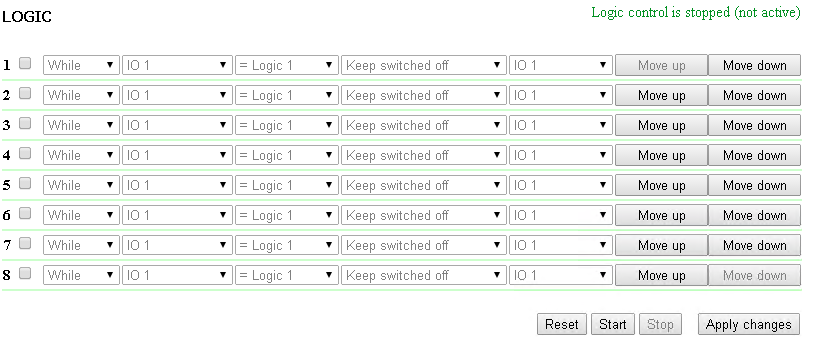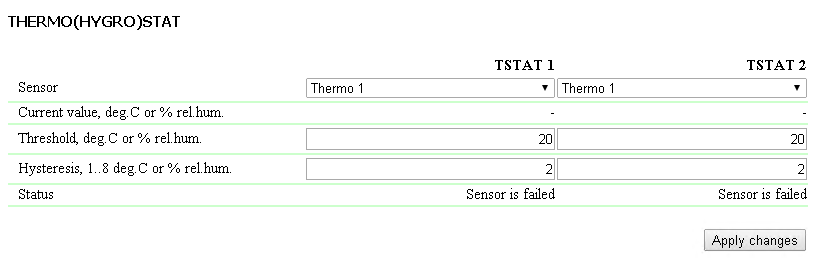[DKSF 48.2 IU] Page LOGIC web interface
This page describes a module operation algorithm and its configuring possibilities. Rules allow to set a flexible logic scheme of managing IO lines and relays of a device depending on varying external conditions. Let us list the following principles of operation and adjustment of Logic: Each position of a rule line is described below. Type of a rule (position 1 in a rule line). - Possible values: «While», «If». «While» rules react on an input status immediately and run constantly. «If» rules react on changing an input status (the second position in a rule line). «While» rule is designed to program conditions under which an output is constantly kept in a specified status, until a condition works. When a condition is not fulfilled, an output status can be changed by other rules. «If» rule is designed to program a short-term reaction to a specified event, such as changing a logic level of an IO line and losing a response when a Pinger works. Until an input of a rule remains unchanged, a rule «If» does not influence status of its output even if a condition of a rule is fulfilled. «While» rules always have a higher priority than «If» rules. For example, when one of the «While» rules keeps an output in a status turned off, rules of «If» type that include an output on a specified event, will not work. Input (position 2 in a rule line) - An input is a source of information for a rule operation. Possible values – RESET, IO1, IO2, IO3, IO4, TSTAT1, TSTAT2, PINGER1, PINGER2. When configuring a logic input, there is a need to take into account the following peculiarities: Depending on the type of a chosen input, a set of conditions for a certain rule varies. Condition (position 3 in a rule line) - is a condition when a rule is applied and a command is issued. This command measures an output status. This value is changed depending on a type of a selected Input and represents a sense of an input status. Possible values for a Pinger are – “Silent”, “Responds”. For an IO line possible values are “log.1”, “log.0”. For a Thermostat possible values are “Below a specified T”, ”Above a specified Т”. A rule of "If" type works only in the moment of fulfilling a condition. A rule of "While" type works all the time when a condition is fulfilled. Command (position 4 in a rule line) - is a command, performed when a rule works (a condition is fulfilled). For an "If" rule possible values are – «Turn on», «Turn off». These commands work in the moment of a condition fulfilling. For a "While" rule possible values are «Keep Turned On», «Keep Turned Off». These commands work all the time when a condition is fulfilled. Output (position 5 in a rule line) - is an output, which is managed by a rule. Its possible values are – IO1, IO2, IO3, IO4 , RELAY1, RELAY2, RELAY3, RELAY4, SNMP1, SNMP2 IR 1, IR 2, IR 3, IR 4 (one of the first 4 IR commands). When configuring a logic output, there is a need to take into account the next peculiarities: A thermostat is used to maintain a temperature. Besides a programmed thermostat, there is a need to set minimum two rules: one rule for turning on a heater or a cooler and another one for turning it off. It is possible to configure no more than two thermostat channels – TSTAT1, TSTAT2. A corresponding thermostat is chosen as a source of information (input) in rules that manage a heater or a cooler. Configuration parameters and a thermostat status are described below . Sensor N – is a number of a temperature sensor, with which a thermostat works. It is possible to plug up to 8 temperature sensors with an individual number from 1 to 8 to a device. On default: 1 A current temperature, degrees С – Current readings of a temperature sensor. Set temperature - is a temperature, which will be maintained by a thermostat (in whole degrees of Celsius, a value can be negative) On default: 20. Hysteresis - Hysteresis sets a "corridor" close to a specified temperature, in limits of which a thermostat does not react to temperature fluctuations. This function allows to avoid occasional frequent switching of a heater (cooler) caused by natural spontaneous fluctuations measured by a temperature sensor. If a current thermostat status is «temperature above a specified one», then a threshold of a status switching is a specified temperature minus a hysteresis value. And vice versa, if a current status is "temperature below a specified one", then a threshold is a specified temperature plus a hysteresis value. As soon as reducing or increasing temperature reaches the value of a threshold (taking into account a hysteresis) and thereby leaves the limits of a corridor, a thermostat status is changed to an opposite one. On default: 2 Status – is a thermostat status. Its possible variants: Sensor Failure, Above Specified Т, Below Specified Т. After setting all necessary values, there is a need to click the button «Apply changes». Pinger checks an availability of a specified address via network. A result of a test (a pinger status) can be selected as an «input» of a rule. It is possible to configure no more than two pingers – PINGER1, PINGER2. A typical use of a pinger is an automatic turning on a power supply of backup equipment if a connection line fails. Parameters of a configuration and a pinger status are described below. Requested address – is an address of a device, which is being checked for its availability. It is allowed to indicate IP address as well as a domain name. An empty page disables requesting. On default: address is not specified Important! In case of using domain names it is necessary to take into account that a DNS server unavailability or a lack of an IP-address for a name in a DNS cache of a device is understood by a module as unavailability of a requested address. As a result, Pinger switches to a status “Silent” Polling period, s (5-900) - is a period of repeating ping tests in seconds. A value is chosen depending on a necessary speed of discovering a failure and on the other hand a limit of a service traffic in a network. Also there is a need to take into account that too frequent power supply switching can decrease a wearout time of equipment. If there is no response, a ping is repeated after timeout is over, not when the next polling period starts. On default: 15 One ping timeout, ms (100-10000) - is time for ping to wait for a response. Timeout is chosen depending on a speed of a local network as well as a frequency of repeating pings that are not responded. If there is no response to ping after a specified timeout is over, ping sending is immediately stopped. If there is still no response after 5 repeated sending, a pinger status is changed to «does not respond», and repeats are stopped until the next polling period starts. On default: 1000 Status – possible values «Responds», «Silent». If requesting is not completed, a status can be undefined. In this case the rules depending on a pinger status, do not form any commands, and their outputs are managed by other rules or keep a previous condition. Pinger status is updated automatically nearly 4 times a minute. After setting up all values there is a need to click the button «Apply changes». SNMP setter sends snmp set requests to an SNMP object. It is possible to configure no more than two setters - SNMP1, SNMP2 Configuration and pinger status parameters are described below. Memo (up to 30 symbols) - is a field for an extra information. On default: is not specified. Address - an SNMP address of an object. On default: address is not specified. Port - an SNMP port. On default: 161 OID (.1.3.6...) - is SNMP object identificators. On default: .1.3.6.1.4.1.25728.5800.3.1.3.1 Community - is settings of administration groups for SNMP. On default: empty. Value "On" (type Integer32) - is a value, which is transmitted to an SNMP object as an "On" signal. On default: 1 Value "Off" (type Integer32) - is a value, which is transmitted to an SNMP object as an "Off" signal. On default: 0 Test - testing transmission of signals Status - is a status of an SNMP object. It may be "available", "timeout" or "waiting for a response" After setting the values it is necessary to click the button «Apply changes». A logic module is designed with the aim of a simple automation and can perform such tasks like maintaining a microclimate, managing an automated turning on/off a backup equipment, etc. Logic works on a basis of the rules, programmed by a user through a web interface.
List of Rules
Thermostat
Pinger
SNMP SETTER



